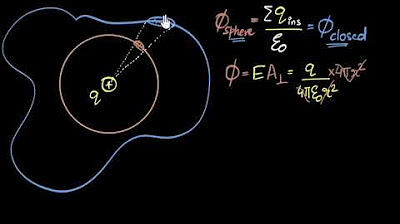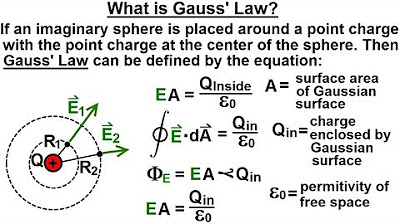Electric Flux and Gauss’s Law | Electronics Basics #6
TLDRThis educational video from howtomechatronics.com delves into the concept of electric flux and Gauss's law. It explains electric flux as the rate of electric field flow through a surface, using examples of both open and closed surfaces to illustrate how flux can be positive, negative, or zero. The video further demonstrates the relationship between electric flux and Gauss's law, showing how the total electric flux through a closed surface equals the enclosed charge divided by the permittivity of free space, epsilon naught. It also covers the application of Gauss's law in scenarios with spherical, cylindrical, and planar symmetry, providing equations for calculating electric fields in each case.
Takeaways
- 🌟 Electric flux is the rate of flow of electric field through a surface, which can be either open or closed.
- 📐 The differential of electric flux, \( d\phi \), through a small area element is defined as the dot product of the electric field magnitude \( E \) and the area vector \( d\vec{a} \), considering the angle \( \theta \) between them.
- 🔍 The total electric flux through a surface is calculated as the integral of \( d\phi \) over the entire area, resulting in a scalar quantity that can be positive or negative.
- 🔄 The unit of electric flux is newton meters squared per coulomb, indicating the amount of electric field penetrating a surface.
- 📊 The flux through different oriented surfaces in an electric field varies based on the angle between the field and the surface normal.
- 🌐 Gauss's law relates the electric flux through a closed surface to the total charge enclosed, divided by the permittivity of free space, \( \epsilon_0 \).
- 🔋 The total flux through a closed surface is independent of the distance from a point charge, as long as the charge distribution is uniform.
- 📏 Symmetry in charge distribution is crucial for calculating electric fields using Gauss's law, with three common types of symmetry: spherical, cylindrical, and planar.
- 🔬 For spherical symmetry, the electric field inside and outside a uniformly charged sphere can be determined using concentric spheres as Gaussian surfaces.
- 📐 In cylindrical symmetry, the electric field due to a line charge can be calculated using a cylinder as a Gaussian surface, considering the charge enclosed and the geometry of the cylinder.
- 🏗 For planar symmetry, the electric field around an infinite charged plane can be determined using a cylinder intersecting the plane as a Gaussian surface, leading to a constant electric field perpendicular to the plane.
Q & A
What is electric flux?
-Electric flux is the rate of flow of electric field through a given surface, representing the amount of electric field penetrating a surface, which can be either open or closed.
How is the differential of electric flux, dΦ, defined?
-The differential of electric flux, dΦ, is defined as the dot product of the magnitude of the electric field (E) and the magnitude of the vector area (dA), multiplied by the cosine of the angle (θ) between these two vectors.
What is the unit of electric flux?
-The unit of electric flux is newton meters squared per coulomb (Nm²/C).
How does the orientation of a surface affect the electric flux through it?
-The orientation of a surface affects the electric flux through it because the angle θ between the electric field vector and the area vector influences the dot product in the flux equation, thus changing the amount of flux.
What is the significance of the normal to a closed surface in calculating electric flux?
-The normal to a closed surface, by convention, points from the inside to the outside of the surface. It is used to determine the direction of the electric field relative to the surface when calculating the total flux through the closed surface.
How is Gauss's Law related to electric flux?
-Gauss's Law states that the electric flux through a closed surface is equal to the sum of all charges enclosed by the surface, divided by the permittivity of free space (ε₀). It is a direct relationship between the total flux and the enclosed charge.
What are the three types of symmetry that simplify the calculation of electric fields using Gauss's Law?
-The three types of symmetry that simplify the calculation of electric fields using Gauss's Law are spherical, cylindrical, and planar symmetry.
How does the electric field inside a hollow sphere with a uniformly distributed charge vary with distance from the center?
-The electric field inside a hollow sphere with a uniformly distributed charge is zero up to the radius of the sphere, and then it reaches its maximum value and decreases as the distance from the center increases.
What is the formula for the electric field around an infinite line of charge with uniform linear charge density (λ)?
-The electric field (E) around an infinite line of charge with uniform linear charge density (λ) is given by E = λ / (2πrε₀), where r is the distance from the line of charge and ε₀ is the permittivity of free space.
How does the electric field behave in the vicinity of a flat, infinite, large, horizontal plate with a uniform charge density (σ)?
-The electric field in the vicinity of a flat, infinite, large, horizontal plate with a uniform charge density (σ) has a constant value of σ / (2ε₀), and it does not depend on the distance from the plane.
What is the electric field between two infinitely large parallel plates with equal and opposite surface charge densities?
-The electric field between two infinitely large parallel plates with equal and opposite surface charge densities is constant and equal to the absolute value of the surface charge density divided by ε₀, pointing from the positively charged plate to the negatively charged plate.
Outlines
🔋 Understanding Electric Flux and Gauss's Law
This paragraph introduces the concept of electric flux, which is the rate at which the electric field flows through a surface, whether it is open or closed. The explanation includes an example of an open surface with a uniform electric field and how to calculate the differential flux through small elements of the surface. The total flux is determined by integrating the differential flux over the entire surface. The paragraph also discusses the significance of the angle between the electric field and the surface normal, and how it affects the flux. The unit of electric flux is defined as newton meters squared per coulomb. The concept is further illustrated with examples involving differently oriented rectangles in an electric field, and the introduction of Gauss's Law is foreshadowed through an example involving a point charge and a spherical surface.
🌐 Gauss's Law and its Application to Symmetric Charge Distributions
This paragraph delves into Gauss's Law, which states that the electric flux through a closed surface is equal to the total charge enclosed divided by the permittivity of free space. The law is illustrated with examples of spherical, cylindrical, and planar symmetries. For spherical symmetry, the electric field inside and outside a uniformly charged thin shell is calculated. The cylindrical symmetry example involves an infinite line of charge, and the electric field at a point above the line is determined. Planar symmetry is exemplified by a uniformly charged infinite large horizontal plate, and the electric field in the vicinity of the plate is calculated. The paragraph explains how the electric field behaves in the presence of different symmetric charge distributions and how Gauss's Law can be applied to find the electric field in each scenario.
📡 Complex Applications of Gauss's Law with Parallel Plates
The final paragraph discusses a more complex scenario involving two infinitely large parallel plates with opposite surface charge densities. It explains how the electric field is determined in the space between and outside the plates using Gauss's Law and the superposition principle. The electric field lines and their directions are described, emphasizing that the field is zero outside the plates and constant between the plates. The summary concludes with a visual representation of the electric field lines, illustrating the principles discussed throughout the video script.
Mindmap
Keywords
💡Electric Flux
💡Gauss's Law
💡Electric Field
💡Differential of Area (dA)
💡Permittivity of Free Space (ε₀)
💡Spherical Symmetry
💡Cylindrical Symmetry
💡Planar Symmetry
💡Surface Charge Density
💡Superposition Principle
Highlights
Introduction to electric flux and Gauss's law, fundamental concepts in electromagnetism.
Electric flux defined as the rate of flow of electric field through a surface, applicable to both open and closed surfaces.
Explanation of differential of area (dA) and its role in calculating electric flux through small elements.
Total flux calculation as an integral over the entire area, with examples of positive and negative flux.
Unit of electric flux is newton meters squared per coulomb, emphasizing its scalar nature.
Demonstration of flux through differently oriented rectangles in an electric field.
Clarification of flux through a closed surface with normals pointing from inside to outside.
Total flux through a closed surface can be positive, negative, or zero, depending on the charge distribution.
Example of flux through a sphere with a point charge at its center, illustrating Gauss's law.
Gauss's law formula: Electric flux through a closed surface equals the enclosed charge divided by permittivity of free space.
Importance of symmetry in calculating electric fields using Gauss's law, with examples of spherical, cylindrical, and planar symmetry.
Calculation of electric field inside and outside a thin hollow sphere with uniformly distributed charge.
Cylindrical symmetry example with an infinite line of charge and the resulting electric field.
Planar symmetry and the calculation of electric field around an infinitely large charged plate.
Graphical representation of electric field magnitude versus distance for different symmetries.
Complex situation of two infinitely large parallel plates with opposite surface charge densities and the resulting electric field.
Superposition principle applied to calculate the total electric field between two charged plates.
Conclusion summarizing the importance of Gauss's law in electromagnetism and its applications.
Transcripts
Browse More Related Video

Ultimate Gauss' Law review

Gauss law of electricity | Electrostatics | Physics | Khan Academy

Gauss law logical proof (any closed surface) | Electric charges & fields | Physics | Khan Academy

Physics 37.1 Gauss's Law Understood (3 of 29) What is Gauss' Law?

Electric Flux (part 1)

Electric Flux, Gauss's Law & Electric Fields, Through a Cube, Sphere, & Disk, Physics Problems
5.0 / 5 (0 votes)
Thanks for rating: